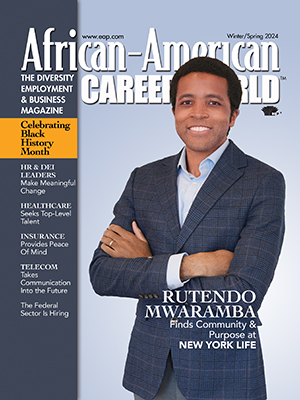| |

African-American Career World Magazine, launched in 2001, is the recruitment link between students and professionals who are African American and the employers that seek to hire them.
The publication includes career strategies, industry trends, and role-model profiles that target the African-American community.
This magazine reaches students, graduate students and professionals at their home addresses.
If you are an African-American college student or professional, African-American Career World is available to you FREE!

|
|
 African-American
African-American
Career World
» Featured Articles
» Subscription Information
» Reader Survey
» Companies Actively Recruiting

Healthy Opportunities in Healthcare for 2020 & Beyond
Global healthcare spending continues to increase dramatically, with it expected to rise at a compound annual growth rate (CAGR) of 5% in 2019-23 and with it also expected to reach $10.059 trillion by 2022. This presents many opportunities for the sector.
While there will be uncertainties, stakeholders can navigate them by factoring in historic and current drivers of change when strategizing for 2020 and beyond.
Among these drivers are rising prevalence of chronic diseases, infrastructure investments, technological advancements, evolving care models, higher labor costs amidst workforce shortages and the expansion of healthcare systems in developing markets.
In response, going forward, healthcare systems need to work toward a future in which the collective focus shifts away from treatment, and toward prevention and early intervention.
These driving factors also include a growing and aging population. This is causing a surge in the sector as the population that will require increasing care with age grows.
Baby Boomers, born between 1946 and 1965, are retiring at the rate of thousands per day. In contrast, Pew Research Center (2018) reports that Millennials, born between 1980 and 1994, currently make up the largest portion of the U.S. labor force, having surpassed Generation X, born between 1966 and 1979, in 2017. This means that about 35% of the American workforce carries the burden of the economy during their prime childbearing years.
With large segments of the population entering their senior years and another with growing families, health professionals will be in demand to meet these increasing needs.
Fortunately, as a result, there’s no shortage of promising healthcare careers in 2020 and beyond:
• Career opportunities in healthcare are broad, and through 2020 demand is predicted to be strongest for dentists, nurses, physician specialists, optometrists, physical therapists and audiologists.
• In addition, demand is also strong for dental hygienists, physician assistants, nurse practitioners and physicians.
• Employment of all healthcare occupations is projected to grow 14% through 2028, much faster than the average for all occupations, adding about 1.9 million new jobs.
• Additionally, demand will also grow for occupational therapy assistants (33%) and physical therapist assistants (27%).
Some of the highest paying jobs are in healthcare, as well:
• For example, the median annual wage for physical therapists is $87,930, and demand for these health professionals is expected to grow by 22% in the decade preceding 2028.
• The median annual wage for healthcare practitioners and technical occupations (such as registered nurses, physicians and surgeons, and dental hygienists) is $66,440, which was higher than the median annual wage of $38,640 for all occupations in the economy.
However, a widening demand-supply gap of skilled professionals is creating immediate challenges for public and private health systems, which may also have long-term, detrimental consequences in 2020 and beyond. The situation appears to be particularly acute within two pivotal medical professions: physicians and nurses.
As healthcare systems consider new methods to source, hire, train, and retain skilled workers to achieve their overall objective going forward, opportunities for those entering healthcare and choosing a profession within it are clearly presenting themselves not only in key patient care roles, but across all departments in these growing healthcare systems.
Sources: U.S. Bureau of Labor Statistics (BLS), BLS’ Occupational Outlook Handbook, medicaltechnologyschools.com, careerprofiles.info, and Deloitte’s 2019 Global HealthCare Outlook and 2020 Global HealthCare Outlook
 » Feedback for the Editor
» Feedback for the Editor
» Request Article Copy
|
|